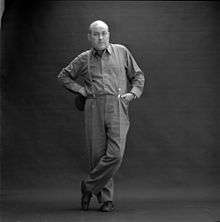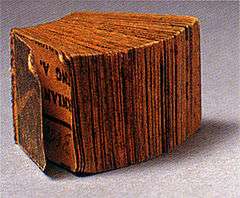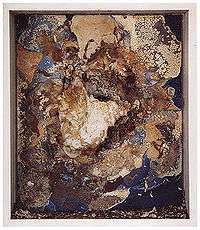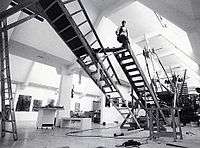Dieter Roth
| Dieter Roth | |
|---|---|
 Rhode Island, USA, 1965 | |
| Born |
Karl-Dietrich Roth April 21, 1930 Hannover, Germany |
| Died |
June 5, 1998 (aged 68) Basel, Switzerland |
| Nationality | Icelandic |
| Known for | Painting, Artist's books, Printmaking, Installation, Sculpture, Poetry |
| Notable work | Literaturwurst |
| Movement | Concrete art, Op Art, Fluxus, Maximalism |
Dieter Roth (April 21, 1930 – June 5, 1998) was a Swiss artist best known for his artist's books, editioned prints, sculptures, and works made of found materials, including rotting food stuffs.[1] He was also known as Dieter Rot and Diter Rot.
The dark undertone and furious, obsessive energy of his work ultimately separated him from many of the more lighthearted Fluxus artists. Perhaps despite himself, he was a fluent draftsman and expert printmaker, and his drawings and prints contained his wild energy within peculiarly virtuosic forms. Compared to the innumerable self-described artists of the last several decades who faked their way through his sort of work, Mr. Roth was the genuine item.[1]
Biography
_page.jpg)
Early life
He was born Karl-Dietrich Roth in Hannover, the first of three sons. His mother Vera was German; his father Karl-Ulrich was a Swiss businessman.[2] After the beginning of World War II, Roth was to spend each summer in Switzerland at the behest of the Swiss charity Pro Juventute, a group trying to protect Swiss-German children from the worst ravages of the war. By 1943 the exile had become permanent, and Roth was sent to live with a family in Zürich. This house, the home of the family of Fritz Wyss, was shared with Jewish and communist artists and actors. It was here that Roth would be encouraged to start painting and to write poetry.[3] He wasn't to be re-united with his family, by now utterly destitute,[4] until 1946.
The family moved to Bern in 1947, where Roth began an apprenticeship in commercial art. His clientele include the local milk association and the cheese union. After seeing an exhibition of Paul Klee's work, "a shock that [was to] grow into an obsession",[5] he gradually moved from the style of commercial art he was being instructed in, towards international modernism.
Spirale and the early books

Roth left home in 1953, and began to collaborate with Marcel Wyss and Eugen Gomringer on the magazine Spirale,[6] of which nine issues would be published (1953–64). Most of his work at this time was in the prevailing Concrete art idiom, exemplified by Max Bill.[7] He took part in a number of local exhibitions, as well as writing poetry, making his first organic sculptures and experimenting with Op art. In 1954 he met the artist Daniel Spoerri whose friendship was to be recalled as "one of the most wonderful things I ever experienced."[8] Spoerri would later set up Editions MAT, a publishing house for editioned books and sculptures, which would print some of Roth's early works.
In 1957 Roth married an Icelandic student Sigríður Björnsdóttir, and moved with her back to Reykjavik.[3] Cut off from centres of European modernism, Roth started publishing a series of highly influential artist's books,[1] and to publish these books he founded, with Icelandic poet Einar Bragi, the publishing company forlag ed.[9] In works such as Bok ("Book") 1958, cut holes in the pages and dispensed with the codex, allowing the reader to rearrange the pages in any order they wished,[10] whilst Daily Mirror Book, 1961, used the found material of a newspaper cut into 2 cm squares and then rebound as a 150-page book.[10]
There would be no way to translate a Dieter Roth book into another medium-the idea of the works is inseparable from their form as books and they realise themselves as works through their exploration of the conceptual and structural features of a book. Johanna Drucker [11]
This processing of found text reached a logical conclusion in his book Literaturwurst (Literature Sausage) 1961. The first copy was made out of a Daily Mirror mixed with spices and foodstuffs from genuine sausage recipes, and stuffed in a sausage skin which he sent to his friend Spoerri.[12] Later copies took books or magazines to create an "ironic"[13] reference to literature. This marked the beginnings of his use of foodstuffs in art, which brought him increasing notoriety throughout the 1960s.
1960s
The William and Norma Copley Award
In 1960 he won the William and Norma Copley Award, which included Marcel Duchamp, Max Ernst and Herbert Read on the jury.[3] As well as a substantial monetary prize, the award included the chance to print a monograph; Roth declined, asking instead for funding to pay for a new work. The end result was his most ambitious book to date, the Copley Book, 1965, a semi-autobiographical deconstruction of the process of book making. In the same year he exhibited at Arthur Köpcke’s gallery in Copenhagen and at the Festival d’Art d’Avant-garde, Paris in 1960, and began an itinerant lifestyle, exhibiting and working throughout Europe, Iceland and America, a pattern he would continue for the rest of his life.
A key breakthrough in his attitude to art was witnessing the performance of Tinguely's Homage to Modern Art in Basel, 1961. The work profoundly impressed Roth, leading to a decisive break with constructivism into post-modern avant-garde practices associated with the Nouveaux Réalistes such as Tinguely and Arman, and the group of artists that were about to become known as Fluxus, including Joseph Beuys and Nam June Paik.[14]
It [Tinguely's Homage to Modern Art] was simply a completely different world from my Constructivism, it was something like a paradise that I'd lost.[15]
Fluxus
Whilst Roth was close friends with many members of early Fluxus,[16] the avant-garde art movement centred around George Maciunas in New York City, he deliberately kept his distance from Maciunas;[17] when asked to add his memories of Maciunas to a biography being compiled by Emmett Williams, he contributed a less-than-complimentary summary;[18] He later told an interviewer;
It was the club of the untalented who made a verbal virtue of their lack of talent so that nobody could say they had no talent. The modesty that they ascribed to themselves was actually a good insight in that sense. Because they had to be modest because they were so incapable." [19]
Still, there are a number of instances of his working within Fluxus; most prominently, his contributions to Spoerri's An Anecdoted Topography of Chance, a collaborative work of cumulative anecdotes by Spoerri, Robert Filliou and Emmett Williams, and published by Something Else Press, (although even this book is debatedly not Fluxus [17]). Spoerri himself has stated that "it doesn't relate to Fluxus", coming as it did before the movement.[20] Either way, Roth contributed anecdotes to the 1968 edition of what has since become known as “arguably the most important and entertaining 'Artist's book' of the post-war period.”[21] He also contributed to V TRe, the Fluxus magazine originally edited by George Brecht, and had work published in An Anthology, published by La Monte Young, Jackson Mac Low and Maciunas in 1963. Roth had also offered his artist's book Literaturwurst to Fluxus as a possible publisher in 1963, around the same time as the early Fluxkits (see Water Yam) but this was turned down by Maciunas.[22]

Biodegradable art
In 1964, Roth was commissioned, alongside several other artists, to paint a portrait of the collector and dealer Carl Laszlo to celebrate his fortieth birthday. Roth took a solarized photo of the Swiss collector, and painted over it with processed cheese "in order to get his goat. I thought he would turn blue and green, like cheese." [23] This became the first of his celebrated biodegradable works. In a series of works called Insel ("Island", 1968), for instance, Roth would take a blue panel, cover it in foodstuffs arranged as islands on the background, cover the surface in yoghurt, then cover that in a layer of plaster, leaving the piece to undergo a series of transformations; mouldy stages, bacterial decay, insect attack, and then stability as only nondegradable elements were left.[24]
Rhode Island, Providence
In 1964 he was offered a post at the Philadelphia Museum of Art, on the understanding that he would create a constructivist book. Roth wanted to make something three-dimensional instead, and was promptly fired. Roth managed to salvage his position and used the next three months to create 6,000 pieces on paper, photographed, printed, re-photographed, drawn over etc., which ended up tacked to the wall; 500 or so were photographed, to be published as a book recording the whole process. He then held a party inviting the students to remove anything they liked; the college rescinded its offer to publish the book, which ended up as Snow, finally printed in 1970.[25] He moved on to Rhode Island School of Design at the beginning of 1965, where his tenure involved teaching at the School of Graphic Design, employing his principle of "non-teaching as teaching".[3] This involved sitting by himself working, refusing to tell his students anything. He also used these students to typeset and print his first book of poetry Scheisse. Neue Gedichte von Dieter Rot (Shit. New Poems by Dieter Rot) 1966. Since the students were unable to speak German, Roth incorporated all their typographical errors into the book.[26]
In 1966 his studio in Providence was cleared out for rent arrears; all but one artwork was destroyed in the process.[3] While in the US, Roth divorced Sigriđur but remained on good terms with the family, by now including three children-Karl, Björn and Vera. Roth would collaborate with his children-especially Björn-for the rest of his life.[27][28][29] In 2010 Hauser & Wirth showed one such collaboration, a selection of collage-assemblages, made from the cardboard mats Roth would place on the worktables in his studios to collect the "traces of domestic activities," such as coffee stains and Björn's childish doodles.[30]
As his notoriety increased, his work rate became prolific with major bodies of work including books of poetry, artist's books, sculptures, paintings, multiples, sound recordings, collaborations with other artists such as Emmett Williams, Hermann Nitsch and Richard Hamilton, jewellery designs, furniture, posters, prints and installations. Of these, it was Installations that gradually became Roth's preferred medium alongside books.

Multiples
Like a lot of his contemporaries in Fluxus, Pop art and Arte Povera, Roth began to produce a series of multiples in the mid-sixties; these editioned sculptural pieces were distinguished by an (extremely) unorthodox approach to materials.[31]
The first multiple was an edition of 100 cakes in the shape of a motorcyclist handed out at the opening to an exhibition of Roth's work at Gallery Hansjorg Mayer. Inevitably, few of these have survived, having been eaten by the visitors.[10] Later multiples used chocolate (Untitled 1969, featuring a doll immersed down to her ankles in chocolate);[10] chocolate and birdseed (P.o.TH.A.A.VFB, 1968, a bust of the artist designed to be left out in the garden [10]); banana (A Pocket Room by Diter Rot, 1968, featuring a slice of banana placed on a print of a kitchen table in a box [10]) and rabbit shit (Rabbit-Shit-Rabbit, 1972, in which the Lindt chocolate bunny mould was re-used, making an immediately recognisable bunny rabbit from rabbit shit.[10])
Other pieces used toy motorbikes, brown sugar, jigsaw puzzles and spices.[10]
1970s
Staple Cheese (A Race)
For his first exhibition in USA, at the Eugenia Butler Gallery of Los Angeles (1970), he exhibited a series of 37 suitcases filled with cheese on the floor, below pictures made with cheese on the wall.[32] Called Staple Cheese (A Race), a pun on Steeple Chase, the suitcases were to be opened one a day, whilst the wall pictures included a horizontal line tracking the vertical movement of the cheeses as they slid toward it. However, within a few days the over-powering smell, maggots and flies combined to make it impossible to enter the room. As a gesture to honor what he called “the exhibition’s true audience,” Roth collected some of the dead flies lying on the floor of the gallery space and put them in a glass jar.[33] The suitcases were later stored in a container designed by Roth for a number of years until Butler's husband threw the whole exhibition away in the desert.[34]
Roth's work became increasingly varied throughout the 1970s. He exhibited manufacturing instructions - the Order Form Exhibitions - for the first show, any buyer could take the directions to a printer of their choice, and create their own print or multiple; second time around, the instructions had to be taken to a baker to create the collector's own baked goods. The same attitude applied to collectors; his most important collector, the German dentist Hanns Sohm, made his own Literature Sausages to Roth's instructions, including Georg Wilhelm Friedrih Hegel’s Work in 20 Volumes.[35] He published the magazine Zeitschrift für Alles (Review for Everything) 1975–1987, promised to publish anything that anyone sent to Roth, the only editorial constraint being the limit of 4 (later 5) pages. By the time Roth announced its demise, the journal had grown to 1396 pages long.[36] The mid seventies also saw a comprehensive attempt to republish all of Roth's bookworks. Instigated by Hansjörg Mayer, a publisher Roth had met in 1963, the Gesammelte Werke (Collected Works) would run to 26 volumes, many of which are still easily available across Europe and America.[37]
96 Picadillies

Roth had started to compulsively paint over postcards in the early sixties, explaining that it was easier to paint over printed objects than blank canvases; one of his most famous works, 96 Picadillies, 1977, grew out of this compulsion, having as its starting point Roth's encounter with the collection of postcards of Picadilly Circus owned by Richard Hamilton and his wife Rita Donagh.[38] Initially, six of these cards were printed as a large scale portfolio in 1970; eventually, in 1977, 96 of these altered Picadillies were collected in a book, including the unaltered backs, with cut marks to allow the buyer to re-use them as postcards.
To facilitate my correspondence, since painting and drawing comes more easily to me than thinking and writing, I [Dieter Roth] have been painting over postcards for a quarter of a century, since painting and drawing on unpainted or unmarked paper is harder to do than on paper with something already on it." Dieter Roth. 1977[39]
Each picture from the series emphasised a different aspect of the scene; one postcard was blanked out everywhere except for the buses circling around Eros; another might add black paint judiciously across the scene to suggest a bustling nightscape.[10]
1980s and 1990s

Garden Sculpture
Roth's installations became larger over the years, and more open-ended. After 1980 they were often created in collaboration with his son Björn and other artists, who would also contribute to the pieces.
Gartenskulptor (Garden Sculpture), for instance, had started out as a copy of the multiple P.O.TH.A.A.VFB, a self-portrait bust made of chocolate and birdseed standing on a bird-table, exposed to the elements. Referred to by Roth as a 'dis- and re-assembly object',[40] each new incarnation gradually acquired working drawings, paintings, sculpted rabbits and collages placed on trellises in collector's gardens. It even acquired a real rabbit and the rabbit's hutch for a number of years. The last time it was installed in a garden was in 1989. When it was exhibited indoors in Switzerland, 1992, Gartenskulptor took up an entire room. By 1995 it was 20m long and included all sorts of objects including a fire ladder and television screens. By 2000, in Mönchengladbach, it was 40 metres long, having acquired elements from each of the installations' incarnations, including pebbly earth excavated by the architects Herzog and de Meuron for the facade of the Schaulager, for instance. The rabbit was no longer present.
Late renown
Roth's work became increasingly celebrated by the 1980s;[3] a number of retrospectives began to be staged throughout Europe, as well as large scale exhibitions of new work. He represented Switzerland at the 1982 Venice Biennale,[3] and received a number of awards and prizes, including the Genevan Prix Caran d’Ache Beaux Arts, a prestigious Swiss prize, in 1991.[3]
Dieter Roth died on 5 June 1998, in his studio in Basel, of a heart attack,[3] and was buried at Arnarstapi on Snaefellsnes, Iceland.
Dieter Roth Academy
In memory of Dieter Roth, every year his close friends (most of them artists, among which: Sigurdur and Kristjan Gudmundsson, Dorothy Iannone, Runa Thorkelsdottir, Jan Voss, Henriette van Egten, Bjorn Roth, Andrea Tippel, Bernd Koberling, Petur Kristjansson, Rainer and Agnes Pretzell, Malcolm Green, Eggert Einarsson e.a.) meet for a conference. Previous meetings have been in:
- Lubeck, Germany (2004)
- Mosfellsbaer, Iceland (2005)
- Xiamen, China (2006)
- Amsterdam, Netherlands (2007)
- Hellnar, Iceland (2008)
- Stuttgart, Germany (2009)
- Hjalteyri, Iceland (2010)
- Berlin, Germany (2011)
- Århus, Denmark (2012)
References
- Book, Roth, 1959/1976
- The Copley Book, Roth, 1965
- 96 Picadillies, Roth, Hansjorg Mayer, 1977
- The Century of Artists' Books, Drucker, Granary, 1994 / 2004
- The Grove Dictionary of Art, Oxford University Press, 1996
- Mr Fluxus, Williams & Noel, Thames & Hudson, 1997
- An interview with Emmett Williams retrieved 08-10-2008
- Roth Time, A Dieter Roth Retrospective, Dobke and Walter, Lars Müller, 2004
- Dieter Roth, Books and Multiples, Dobke, Hansjörg Mayer, 2004
- Roth In America, Dobke and Becker, Thames & Hudson, 2004
- Dieter Roth. Zeichnungen - Drawings, Eva Presenhuber (ed.), JRP, Zurich, 2007
- The Dieter Roth Foundation
- A Dieter Roth biography at MoMA Online
- Dieter Roth, New York Times Obituary, 08-10-1998, retrieved 08-10-2008
Notes
- 1 2 3 Dieter Roth, Quoted in the New York Times Obituary, 10-06-1998
- ↑ Roth Time, Dobke, Walter, Lars Muller, 2004 p. 18
- 1 2 3 4 5 6 7 8 9 "Dieter Roth Foundation Biography". dieter-roth-foundation.com. Retrieved 2016-05-20.
- ↑ Roth Time, Dobke, Walter, Lars Muller, 2004
- ↑ Roth Time, Dobke, Walter, Lars Muller, 2004, p22
- ↑ Roth Time, Dobke, Walter, Lars Muller, 2004 p32
- ↑ Artnet Online retrieved 2008-10-10.
- ↑ Roth Time, Dobke, Walter, Lars Muller, 2004, p33
- ↑ Buhmann, Stephanie (April 2004). "Roth Time: A Dieter Roth Retrospective". The Brooklyn Rail. Retrieved 2010-01-01.
- 1 2 3 4 5 6 7 8 9 Dieter Roth Books + Multiples, Dobke, Hansjörg Mayer, 2004
- ↑ The Century of Artists' Books, Drucker, Granary, 2004, p.75
- ↑ Dieter Roth Books + Multiples, Dobke, Hansjörg Mayer, 2004, p9
- ↑ Roth, Wien 2002, p48, quoted in Dieter Roth Books + Multiples, Dobke, Hansjörg Mayer, 2004
- ↑ Artnet Online retrieved 2008-10-08.
- ↑ Roth, quoted in Artnet Online retrieved 2008-10-08.
- ↑ Spoerri, Emmett Williams, Tinguely and others.
- 1 2 Interview with Emmett Williams retrieved 2008-10-08.
- ↑ "I can't write much-met him 2 times-. Kind of teacher: compensates lack of talent with scolding...gets envious fellows (the girls were softer) together (flux) and makes lack of liveliness into a (restricting) morale. Ornamenter, though." Roth, 1993, quoted in Mr Fluxus, Williams Noel, Thames & Hudson, 1997 p328
- ↑ Quoted in Artopia retrieved 08-110-2008
- ↑ cf. An Anecdoted Topography of Chance, Atlas Press, London 1995, p. 15
- ↑ "An Anecdoted Topography of Chance - The Art and Popular Culture Encyclopedia". artandpopularculture.com. Retrieved 2016-05-20.
- ↑ Roth Time A Dieter Roth Retrospective, Dobke, Lars Muller, 2004 p74
- ↑ Roth, quoted in Roth Time, Dobke and Walter, Lars Müller, 2004, p77
- ↑ Artcritical.com Review retrieved 2008-10-07.
- ↑ Diether Roth in America Dirk Dobke Hansjorg Mayer, 2004 p. 19
- ↑ Roth Time, Dobke, Walter, Lars Muller, 2004 p. 95
- ↑ Roth Time, Dobke, Walter, Lars Muller, 2004 p171
- ↑ Collaborations with Björn include a 1995 exhibition Björn and Dieter Roth; Archive of the Everyday at the Vienna Secession 1995; with Karl & Björn include Blowers, 1987-93, and with Vera & Björn include Cellar Duet, 1989
- ↑ Björn has continued to carry on his father's legacy at his request; Roth Time, Dobke, Walter, Lars Muller, 2004 p244
- ↑ Oisteanu, Valery (November 2010). "DIETER ROTH, BJÖRN ROTH: Work Tables & Tischmatten". The Brooklyn Rail.
- ↑ Roth Time, Dobke, Walter, Lars Muller, 2004 p116
- ↑ Dieter Roth essay, Oxford Art Online
- ↑ "Rot (2011) < Eva and Franco Mattes". 0100101110101101.org. Retrieved 2015-11-12.
- ↑ Roth Time, Dobke, Walter, Lars Muller, 2004 p131
- ↑ Roth Time, Dobke, Walter, Lars Muller, 2004 p74
- ↑ Roth Time, Dobke, Lars Müller, 2004 p172
- ↑ "Welcome to Boekie Woekie". xs4all.nl. Retrieved 2016-05-20.
- ↑ "Dieter Roth Foundation: Dieter Roth The Piccadillies". dieter-roth-foundation.com. Retrieved 2016-05-20.
- ↑ quoted in Roth Time, Dobke, Walter, Lars Mūller, 2004, p.122
- ↑ Roth Time, Dobke and Walter, Lars Müller, 2004, p242
External links
- Publications by and about Dieter Roth in the catalogue Helveticat of the Swiss National Library
- Dieter Roth Foundation and museum website
- Roth Time: a Dieter Roth retrospective — Museum of Modern Art (New York)
- Dieter Roth in artnet Monographs
- Boekie Woekie, artist bookstore Amsterdam. Books by Dieter Roth.
- Dieter Roth biography and exhibition review by cosmopolis.ch
- Dieter Roth Academy
- A Collection of his work in the Tate
- Dieter Roth on the website of his gallery Eva Presenhuber